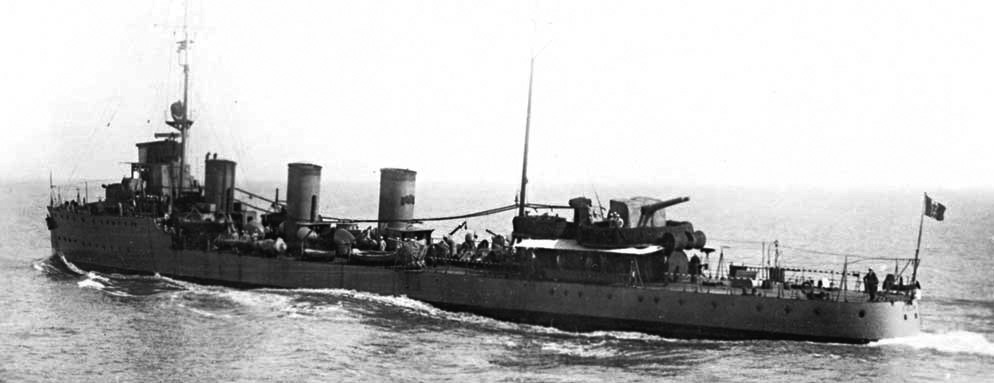
 Scouts (cruisers) 1914-1950:
Scouts (cruisers) 1914-1950:Aquila, Sparviero, Nibbio, Falco (eagle, sparrowhawk, kite, falcon).
Later Mărăști and Mărașești (1920), Ceuta and Melilla (1937), Lovkij, Legkij (1944).
WW2 Italian Destroyers
Poerio | Aquila | Mirabello | Leone | Sella | Sauro | Turbine | Navigatori | Freccia | Folgore | Maestrale | Oriani | Soldati | Medaglie d’OroWW2 Italian Torpedo Boats
Indomito | Audace | Audace(ii) | Pilo | Sirtori | La Masa | Generali | Palestro | Curtatone | Albatros | Spica | Pegaso | Ciclone | ArieteThe Aquila class were four flotilla leaders built in Italy during the First World War, requisitioned after they had been order by Romania in 1913, and thus, taking part in the first world war, resold to Romania postwar and also Spain for the second pair, and eventually owned by the Soviet union until 1950 for the ex-Romanian ships as war reparation. Quite an interesting fate for these “birds of prey” (as named), armed with cruiser guns but destroyer-size (and later classed as such), which had a long and colorful career through WW1, WW2 and the cold war. #regiamarina #aquila #nibbio #sparviero
Development
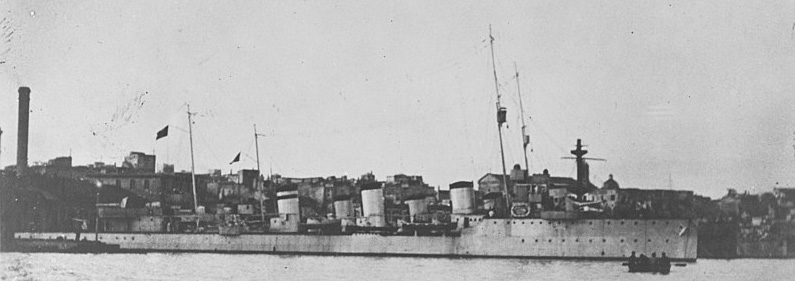
Nibbio and Sparviero during the war in Brindisi
These four warships were never intended to be Italian, they were ordered in 1913 as part of the largest naval expansion program by the Kingdom of Romania, twelve powerful destroyers in all. The first batch of four was ordered from the Pattison Shipyard in Naples. Initial names were “Vifor”, “Viscol”, “Vârtej” and “Vijelie”. As specified they were supposed to carry cruiser guns in order to perform scouting and be able to replicate against larger ships if needed. Still by size and tonnage they were small.
They had been designed by engineer Luigi Scaglia interpreting Romanian specifications for large destroyers pwerfully armed with three 120 mm guns in a lozenge patter, completed by four 75 mm guns, and even five torpedo tubes. It was specified also a 10-hour endurance, full speed, for quick raids in the Black Sea. These were laid down after the plans were submitted and approved and funds transferred, on 29 January 1914, 15 July 1914 and 11 March 1914 for the first three, respectively and as a slipway was freed after launch of the first, Viscol was laid down in turn on 19 August 1916. At that stage Italy was at war since 1915.
They were interned since 5 June 1915, completed respectively to completed 60%, 50%, 20%, then requisitioned, despite the fact Romania was on the same side, with the entente and against the central Empires. Once modifications were secured for Italian service, they were launched (Aquila was the first on 26 July 1916, followed by Sparviero in March 1917, Nibbio in January 1918. They were completed as scout cruisers (esploratori) when commissioned from 8 February 1917 (Aquila), 15 July 1917 (Sparviero), and 15 May 1918 (Nibbio); So they all took part in the great war (see below). Not however Falco, suspended, then launched on 16 August 1919 and completed on 20 January 1920. Note the naming (bird of prey for them, felines for the Leone class) inspired French early interwar large destroyers names.
Design of the class
Hull and general design
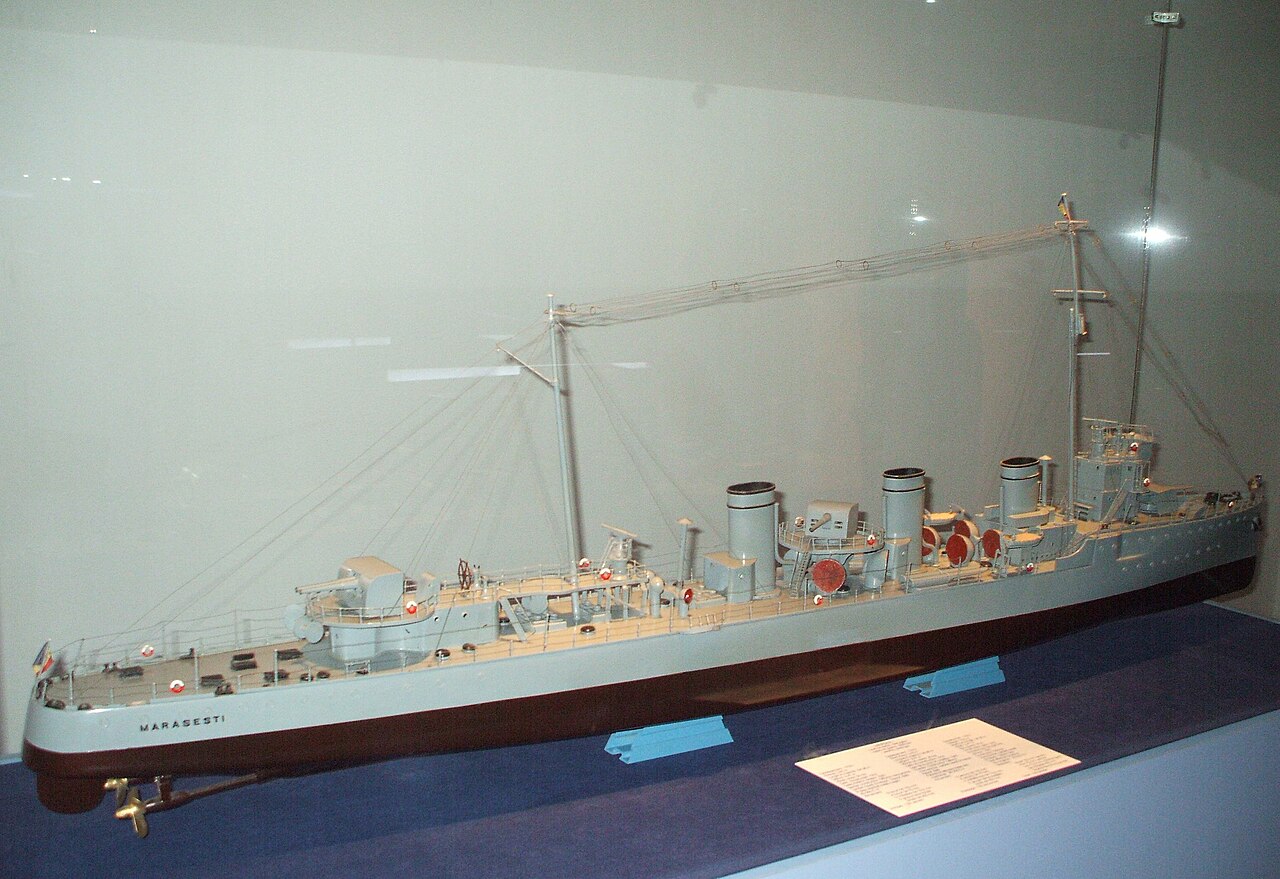
A yard model of the class, as the modernized NMS Marasesti in 1927. Note the extra 120 mm single gun between funnels, later removed to add extra AA during WW2.
These “scout cruiser” were indeed much larger than the average Italian destroyers of the time, and yet much smaller than vessels like the Quarto. At 1,432 tons standard, and 1,751 tons at full load displacement for 94.7 meters in length, 9.5 meters in beam, a draught of 3.6 meters it was hoped they would be sturdy enough to support their planned armament. With many extra addition in WW2 this displacement skyrocketed.
The hull was “classic” for a destroyer with a long forecastle, straight stem and rounded stern. The hull lines presented no similar section for the whole lenght with a constant ellipse. The imposing machinery produced a profile with three equal size oval funnels heavenly spaced and raked, as the two masts fore and aft. The superstructure bridge was small on two levels, with an enclosed and open bridge above, and the map room below. The two main guns, massive were installed in tandem forward with sponsons. The third was located on the quartedeck house aft, axial. On deck aft were installed two lines or mine rails, only on less than 1/3 of the lenght. Space indeed was interrupted by the aft pair of decked 3-in guns, and the twin torpedo tubes mount amidships. These ships carried for their crew of 148 officers and ratings, two yawls forward, two whalers aft under davits, and one small cutter manipulated by a small gooseneck crane.
Powerplant
The Aquila powerplant rested on a pair of propeller shafts, each a bronze three leaf model, with shafts turned by a pair of Tosi steam turbines. Themselves were fed by the steam coming from five Thornycroft boilers, for a designed output of 40,000 shaft horsepower (30,000 kW), providing a top speed of 34 knots (63 km/h; 39 mph). But since they came frm ifferent yards, on trials thhis varied up to 35 and 38 knots light, depending of each. Range also as designed was 3,000 nautical miles (5,600 km; 3,500 mi) at 15 knots (28 km/h; 17 mph) or 1,700 nautical miles at 20 knots, 380 nautical miles at 34 knots (top speed, in combat order). The rudder was single, rounded a,d relatively small, and agility was not their strong point but it seems they were recoignized as stable platforms wth a predictable roll.
Armament
The original armament as precised by Romania was to be lighter, with three 120 mm guns, but it was upgraded when requisitioned to be upgraded a s”scout cruisers”, Nibbio and Sparviero being each armed with three 152 mm Armstrong guns instzad, and completed by four 76 mm dual-purpose Ansaldo guns. The first pair however, Aquila and Falco were completed two twin 120 mm guns, two 76 mm Ansaldo guns, a very different arrangement. Each however came with two twin 457 mm torpedo tubes with two 6.5 mm Breda light machine guns for AA defence. Only Nibbio and Falco were modified with rails on the aft deck, in order to carry mines, 24 and 38 respectively between them.
Main Armament
All four ships were initially armed with three Vickers Arsmtrong 152 mm QF 6 in/40 placed in a triangle pattern two forward in tandem with deck sponsons to operate them at most angles, and one aft on the deckhouse. These old reliable models first designed in 1892 weighted each 6.700 kg for a barrel lenght 6,096 m, exact caliber of 152,4 mm and firing 45 kg HE round at 5-7 rpm and 657 m/s up to 9.000 m range at 30° max. They brought twice as heavy rounds but 1/3 closer compared to the later upgrade to twin 120 mm. Number of rounds carried unknown.
1927 Modernization: 2×2 120 mm/45
They all were modernized with two twin mounted 120 mm/45 Canet-Schneider-Armstrong under shields. These originally were to be five originally, with one extra single gun aft. The forward twin mount was placed on deck, forecastle, the second elevated on the quarterdeck house. Model 1918 existed in single mounts, Model 1918/19 in twin mountings as the following interwar models. They were also found on the Leone, Sauro, Turbine and Sella classes destroyers. 9,600 lbs. (4,354 kg), 196.3 in (4.985 m) long, 7 rpm, firing HE 48.5 lbs. (22 kg) or AP 51.0 lbs. (23.15 kg) rounds, at 2,789 fps (850 mps) and at 33° 16,950 yards (15,500 m) range.

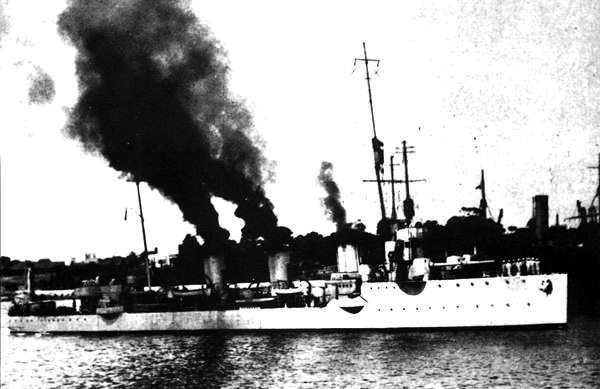
Aquila during the first world war
AA: Ansaldo 3-in DP
The 76.2 mm/40 (3″) Ansaldo modello 1916 and 1917 were dependable dual purpose atillery piece, unshielded. Both ships sub-class diverged, Aquila and Falco having just two, placed on sponsoned deck position aft, close to the quartdeck house. The Nibbio sub-class had an extra pair, also located on sponsons positions but behind forecastle recesses forward, on the weather deck also.
It should be noted that the ship carried two Barr & Stroud type telemeters fore and aft. The forward one was on top of the bridge, and the aft one on a platform at the step of the raked aft mast.
Torpedoes: 2×2 18-in
Both sub-classes had the same pair of twin torpedo tubes, 450 mm or 18 inches models, Thornycroft models built in Italy. No data available on their specs.
Mines:
Only the sub-class Nibbio had mine railed installed on the aft deck. They carried respectively 24 (Nibbio) and 38 (Falco) of these due to shorter rails for the former or larger mines, no data avilable. These mines, according to Navweaps would either be the French Sautter-Harlé 70 M1916 type with 154 lbs. (70 kg) charge and 330 foot (100 m) mooring cable or the Sautter-Harlé 100 M 1916 with 220 lbs. (100 kg) charge and 330 foot (100 m) mooring cable. Other sources gave 44 mines as max carried.
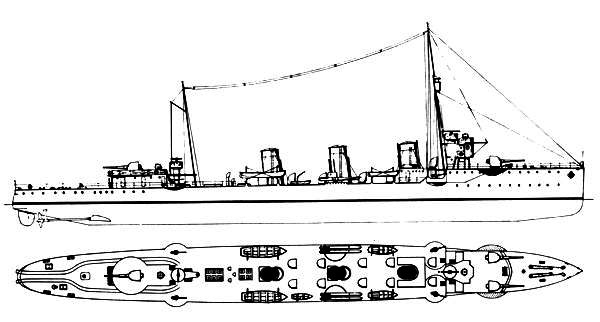
Profile and top of the Nibbio sub-class (15 cm guns)
⚙ specifications |
|
| Displacement | 1,594 long tons normal, 1,760 long tons full load |
| Dimensions | 94.3 x 9.5 x 3.6 m (309 ft 5 in x 31 ft 2 in x 11 ft 10 in) |
| Propulsion | 2 shafts; 2 geared steam turbines, 4 Thornycroft boilers 40,000 shp (30,000 kW) |
| Speed | 34 knots (63 km/h; 39 mph) |
| Range | 3,000 nmi (5,600 km; 3,500 mi) at 15 knots (28 km/h; 17 mph) |
| Armament | 3× 152 mm (6 in), 4× 76 mm (3 in) AA, 2×2 457 mm (18 in) TTs, 24–44 mines |
| Crew | 146 |

Spanish Ceuta class (Pinterest). Note the fully enclosed top bridge and fake fourth funnel aft
Read More/Src
Books
Pier Paolo Ramoino, Gli esploratori italiani 1919-1938 su Storia Militare n. 204 sept. 2010.
M.J. Whitley, Destroyers of World War 2, Cassell Publishing, 1988
Andrea Filippo Saba, L’imperialismo opportunista. Politica estera italiana e industria degli armamenti (1919-1941), Napoli,
Conway’s all the world’s fighting ships 1922-1947
Links
marina.difesa.it/
commons.wikimedia.org/ Category:Aquila_class
military-history.fandom.com/ Aquila-class
navweaps.com italian guns
wikipedia.org Vifor-class_destroyer
on kbismarck.com
navweaps.com/ italian mines
agenziabozzo.it/ AQUILA at the yard
on forum.paradoxplaza.com
on trentoincina.it/
foro.todoavante.es on the ceuta class
hagenziabozzo.it SPARVIERO 1918
naviecapitani.it/
navypedia.org/ marasti.htm
navypedia.org aquila.htm
 Aquila
Aquila
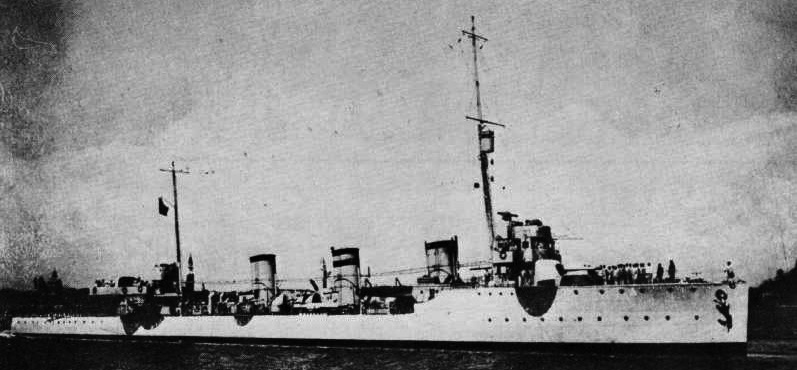
Aquila in WWI
Aquila entered service in 1917 and was mainly used in the Adriatic in skirmishing actions. She was stationed in Brindisi. On the night of 14-15 May 1917, the Otranto Canal saw its armed fishing boats attacked by an Austro-Hungarian flotilla while a diversionary action targeted an Italian convoy headed to Albania. So at 4.10am on 15 May Aquila was called to action with Racchia and Marsala, and British light cruiser HMS Liverpool, the destroyers Insidioso, Impavido and Indomito. At 5.30 light cruiser HMS Dartmouth and two other destroyers joined in and they were in sight of the Austrians at 7.45, spotting the DDs Csepel and Balaton. At 8.10 Aquila and destroyers attacked these, which replocated at 8.15, Balaton being hit almost immediately, Aquila in turn having a boiler room hit, killing 7 and she came to a dead stop.
At around 9:00 AM Saida, Helgoland and Novara arrived on the scene and dispersed the Italians. However Aquila still dead on the water, signalled her fate, and she was covered by the destroyers Mosto and Acerbi and HMS Bristol and Dartmouth interposed themselves, opening fire and forcing the Austrian back. Aquila was towed back to port.
On the night 4-5 October 1917 she was in distant support with Racchia, for an air raid on Cattaro, in case any ship escaped.
On 19 October she left Brindisi with sister ship Sparviero, HMS Gloucester and Newcastle, French DDs Commandant Riviere, Bisson, Bory and Italian Indomito, Mosto and Missori i chase of the Austrian scout Helgoland, destroyers Lika, Triglav, Tátra, Csepel, Orjen and Balaton preying on Italian convoys. Heligoland and Lika lured the allies however into an ambush by U-Boats U 32 and U 40, and later to complicate things, there were Italian air attacks? Eventually all returned to port safe.
On 28 November Aquila and Sparviero with DDs Animoso, Ardente, Ardito, Abba, Audace, Orsini, Acerbi, Sirtori and Stocco, headed for north Venice covered by Italian reconnaissance seaplanes, chasing an Austrian formation (DDs Dikla, Streiter, Huszar 4 torpedo boats) which shelled a railway near the mouth of the Metauro. Short on coal, the Italians broke chase off Cape Promontore, too close to Pola batteries.
On 10 May 1918 they sailed to Porto Levante with Acerbi, Sirtori, Stocco, Ardente and Ardito, providing cover for a MAS diversionary raid, the “Buccari hoax”.
On 5 September all three sisters (Aquila, Sparviero, Nibbio) escorted TBs 8 PN and 12 PN, 15 miles from Punta Menders, attacking Austrian merchant traffic from Durazzo. The scoits stayed 15 miles west as distant cover. At 12.35, 8 PN identified three enemy ships off Ulcinj and attacked with 12 PN, and then called the scouts to chase back the three Austro-Hungarian ships.
On 2 October 1918 Aquila, Nibbio and Sparviero patrolled off the coast of Durazzo for a possible counterattack. The war was near its end.
On 15 November 1918 Aquila and the Sparviero carried occupation troops and landed them, taking possession of Lesina.
Interwar service 1919-37
In 1927 Aquila had her 152 mm guns replaced with four 120 mm guns in twin mounts. On 6 August 1928 she sailed from Pola for a fleet exercise wit the light cruiser Brindisi and V Destroyer Flotilla, and a simulated attack on submarines F 14 and F 15. After 8.40 the destroyer Missori rammed F 14, which sank off San Giovanni in Pelago, Aquila being first and started to help, locating the wreck of the submarine stll unflooded but with 23 crew members trapped alive. When F 14 was lifted, the anchor chain of Aquila caused the submarine to list, and it was hooked to the 30 ton pontoon GA 145, so she could be freed from the anchor chain and surfaced. But at that time, the entire crew already died.
On 11 October 1937, the Spanish War hd Mussolini deciding to help its ally Franco and the Nationalists, handing over Aquila and her sister Falco. Under the nationalist Spanish Navy, officilly transferred on 6 January 1939 they became the ceuta class (see below).
 Falco
Falco

On 5 June 1915 the former Viscol was requisitioned and renamed Falco, but she was completed after the war in 1920.
Between 4 and 5 March 1921 she carried King Vittorio Emanuele III from Civitavecchia to Sanremo, for the funeral of the King of Montenegro Nicholas I which passed out at Antibes, 1 March 1921.
In 1927 she was modified like her sister.
On 11 October 1937, the Spanish War saw her handed over to the nationalist Spanish Navy, officially on 6 January 1939, and she served as lead ship of the Spanish class as Ceuta (see below).
 Nibbio
Nibbio
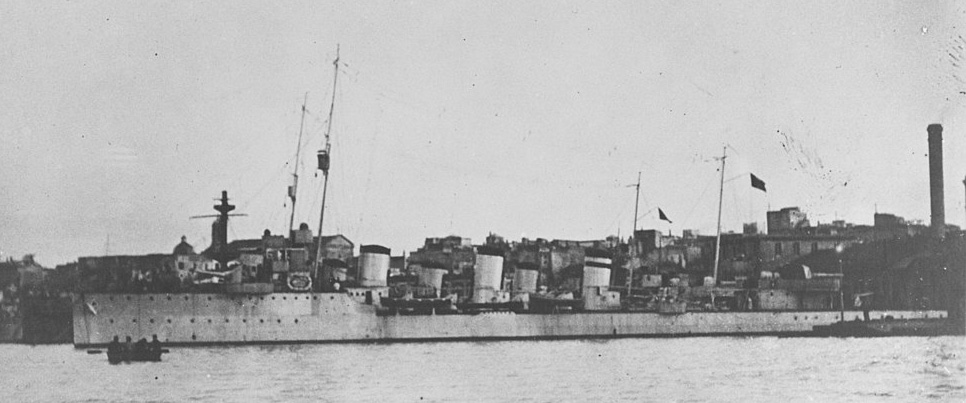
Nibbio and Aquila in Brindisi during the war
Built at Pattison shipyards, Naples as Vârtej on 5 June 1915 she was requisitioned, renamed Nibbio, completed in 1918. Her career resembled Aquila and Sparviero.
On 5 September 1918, Nibbio and sisters Aquila and Sparviero covered the TBs 8 PN and 12 PN for the Durazzo raid (see above).
On 2 October 1918 she was sent to the coast of Durazzo to counter a possible counterattack from Cattaro to prevent the shalling of Durazzo by enn=tente ships.
On 4 November 1918 Nibbio, under command of the frigate captain Grixoni, left Valona carryinf aboard the “Grado” marine infantry battalion and in the afternoon landed them to kae possession of Curzola, in the name of Italy, occupation strongly opposed by loicals.
The following day she was in support to the occupation of Sebenico by troops carried by the TBs Albatros and Pallade and two MAS.
On 1 July 1920, Nibbio was sold to the Romanian Navy with Sparviero and renamed Mărășești (see below).
 Sparviero
Sparviero

Ordered by the Romanian Navy in 1913, laid down in Pattison shipyards, Naples as Vijelie she was requisitioned, renamed Sparviero, entering service in 1917. Like her sisters she was used in the Adriatic.
On 29 September 1917 under command of captain Ferdinando di Savoia, Principe di Udine she sailed out with the DDs Abba, Acerbi, Orsini, Stocco, Ardente, Ardito and Audace in support of a an air raid against Pola. At 10.03pm she sighted enemy 2 miles away rushing to attack them together with destroyers. The formation (destroyers Turul, Velebit, Huszar and Streiter and 4 torpedo boats) had then a brief evening clash from 10.05pm until 10.30pm, then at 11.45pm until both forces departed. No hits were reported either side.
On 19 October she left Brindisi with Aquila, Gloucester and Newcastle to chase a formation led by KUKMS Helgoland preying on Italian convoys. They escaped the ambush (U 32 and U 40) and eventually the attack ended with an air raid.
On 28 November, Aquila and Sparviero with 8 DDs sailed from Venice in search of an Austrian formation signalled shelling the mouth of the Metauro. It stopped at Cape Promontore.
On 5 September Aquila, Sparviero, Nibbio suported 8 PN and 12 PN (see above).
On 2 October 1918 she took part of the patrol off the coast of Durazzo as counter to a possible counterattack.
On 4 November 1918 she left Valona with part of the “Grado” Marine Infantry Battalion, crossed minefields and landed them at Meleda for occupation.
On 15 November with Aquila she took possession of Lesina.
Postwar, she was resold to the Romanians in july 1920 as Mărăști.
 Mărăști (ex-Vifor) class
Mărăști (ex-Vifor) class
Mărăști, Mărășești

Mărăști and Mărășești when entering Romanian service became overnight the most heavily-armed Axis warships in the Black Sea.
 Upon commissioning on 1 July 1920 they were re-classified as destroyers with some sources referring them as flotilla leader due to their 152 mm guns. Mărăști and Mărășești were refitted at Galați shipyard in 1925 completed in Naples for rearming in 1926 with the same twin 120 mm guns, more one extra single, and more modern AA.
Upon commissioning on 1 July 1920 they were re-classified as destroyers with some sources referring them as flotilla leader due to their 152 mm guns. Mărăști and Mărășești were refitted at Galați shipyard in 1925 completed in Naples for rearming in 1926 with the same twin 120 mm guns, more one extra single, and more modern AA.
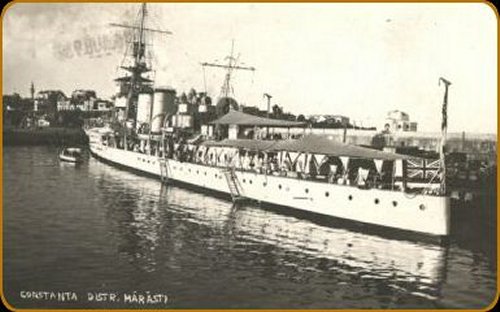
In 1939, they had five 120 mm guns, four 76 mm DP guns, the same torpedo tubes and two light machine guns plus longer railed to carry 50 mines. They became the bderock of the Royal Romanian Navy. However as spatbility issues, and the need for more AA emerged, they lost one 120 mm and two 76 mm for the addition of two 37 mm and four 20 mm anti-aircraft guns and two special depth charge throwers of 900 mm and 330 mm.
On 26 June 1941, Mărăști repelled a Soviet naval attack on Constanța with the DD Regina Maria and minelayer Amiral Murgescu. The destroyer leader Moskva was lost in a minefield on 19 June. Mărăști claimed also one Soviet bomber.
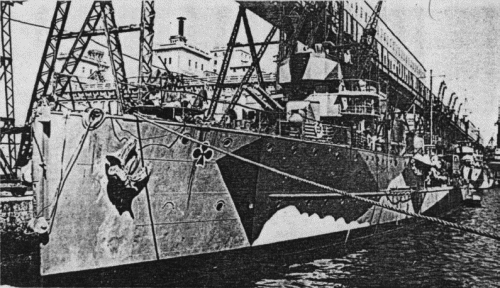 Both became active during the Romanian Naval campaign , provding vital escort for Axis supply convoys between Romania and Crimea-Bosphorus. 28 and 21 missiones repectively were performed, 55 total, fending off Soviet submarines and aviation attacks, crossing the path of mines. As the war ended, the Soviet forces captured Constanta and the ships present including the two DDs, that were pressed into Soviet service for a short time, between August 1944 and October 1945 and then returned to Romania. Mărășești served until 1965.
Both became active during the Romanian Naval campaign , provding vital escort for Axis supply convoys between Romania and Crimea-Bosphorus. 28 and 21 missiones repectively were performed, 55 total, fending off Soviet submarines and aviation attacks, crossing the path of mines. As the war ended, the Soviet forces captured Constanta and the ships present including the two DDs, that were pressed into Soviet service for a short time, between August 1944 and October 1945 and then returned to Romania. Mărășești served until 1965.
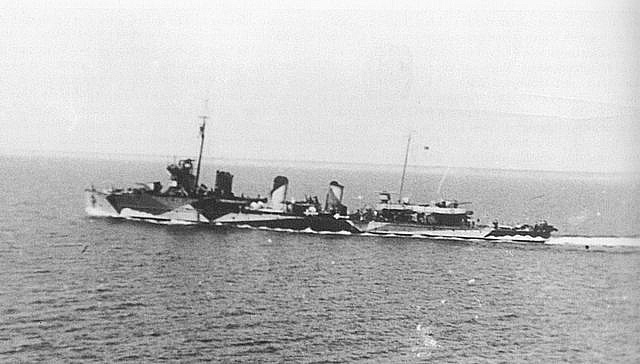

Both ships, camouflaged, in escort missions. They proved vital for axis convoys as neither the Italians or Germans could send thips there, with the Bopshorus closed by neutral Turkey.
 Ceuta class
Ceuta class
Melilla, Ceuta

Aquila and Falco became destroyers on 5 September 1938, renamed Ceuta-Melilla under Spanish service, but were only stricken and officially transferred on 5 January 1939. The Nationalisyt Navy, crippled, was down at the time to just the single destroyer Velasco. One attempt to conceal their transfer was renaming them Velasco-Ceuta and Velasco-Melilla and adding a fourth fake funnel to make them resemble the smaller Velasco. Postwar, they were used as training ships, stricken by late 1950.
They were mainly used in surveillance and escort duties, and in August 1938 Ceuta and Melilla escorted the cruiser Canarias on a raid seeing the republican destroyer José Luis Diaz damaged, fleeing to Gibraltar after Ceuta hit Diaz, causing heavy damage. Another action was the capture of the French merchant ship Prado carrying arms to the republicans. She was striken in 1948.
 Lovkiy class
Lovkiy class
Both Romanian ships were captured by Soviets troops entering Constanta in August 1944 after the capitulation of Romania. They entired service in the Black Sea Fleet for a short while as Lovkiy (ex-Mărăști) and Lyogkiy (ex-Mărășești) until returned by October 1945, resuming their career as TS in the Romanian Navy until the late 1950s, having ordering these originally in 1913…

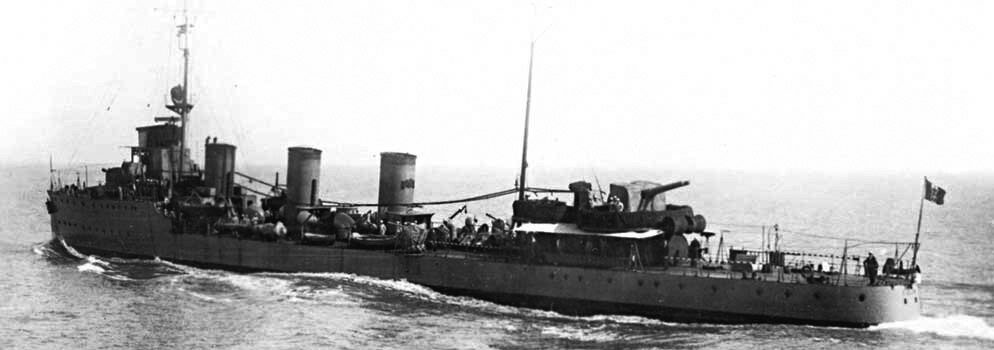
 Latest Facebook Entry -
Latest Facebook Entry -  X(Tweeter) Naval Encyclopedia's deck archive
X(Tweeter) Naval Encyclopedia's deck archive Instagram (@navalencyc)
Instagram (@navalencyc)





 French Navy
French Navy Royal Navy
Royal Navy Russian Navy
Russian Navy Armada Espanola
Armada Espanola Austrian Navy
Austrian Navy K.u.K. Kriegsmarine
K.u.K. Kriegsmarine Dansk Marine
Dansk Marine Nautiko Hellenon
Nautiko Hellenon Koninklije Marine 1870
Koninklije Marine 1870 Marinha do Brasil
Marinha do Brasil Osmanlı Donanması
Osmanlı Donanması Marina Do Peru
Marina Do Peru Marinha do Portugal
Marinha do Portugal Regia Marina 1870
Regia Marina 1870 Nihhon Kaigun 1870
Nihhon Kaigun 1870 Preußische Marine 1870
Preußische Marine 1870 Russkiy Flot 1870
Russkiy Flot 1870 Svenska marinen
Svenska marinen Søværnet
Søværnet Union Navy
Union Navy Confederate Navy
Confederate Navy Armada de Argentina
Armada de Argentina Imperial Chinese Navy
Imperial Chinese Navy Marinha do Portugal
Marinha do Portugal Mexico
Mexico Kaiserliche Marine
Kaiserliche Marine 1898 US Navy
1898 US Navy Sovietskiy Flot
Sovietskiy Flot Royal Canadian Navy
Royal Canadian Navy Royal Australian Navy
Royal Australian Navy RNZN Fleet
RNZN Fleet Chinese Navy 1937
Chinese Navy 1937 Kriegsmarine
Kriegsmarine Chilean Navy
Chilean Navy Danish Navy
Danish Navy Finnish Navy
Finnish Navy Hellenic Navy
Hellenic Navy Polish Navy
Polish Navy Romanian Navy
Romanian Navy Turkish Navy
Turkish Navy Royal Yugoslav Navy
Royal Yugoslav Navy Royal Thai Navy
Royal Thai Navy Minor Navies
Minor Navies Albania
Albania Austria
Austria Belgium
Belgium Columbia
Columbia Costa Rica
Costa Rica Cuba
Cuba Czechoslovakia
Czechoslovakia Dominican Republic
Dominican Republic Haiti
Haiti Hungary
Hungary Honduras
Honduras Estonia
Estonia Iceland
Iceland Eire
Eire Equador
Equador Iran
Iran Iraq
Iraq Latvia
Latvia Liberia
Liberia Lithuania
Lithuania Mandchukuo
Mandchukuo Morocco
Morocco Nicaragua
Nicaragua Persia
Persia San Salvador
San Salvador Sarawak
Sarawak Uruguay
Uruguay Venezuela
Venezuela Zanzibar
Zanzibar Warsaw Pact Navies
Warsaw Pact Navies Bulgaria
Bulgaria Hungary
Hungary

 Bundesmarine
Bundesmarine Dutch Navy
Dutch Navy Hellenic Navy
Hellenic Navy Marina Militare
Marina Militare Yugoslav Navy
Yugoslav Navy Chinese Navy
Chinese Navy Indian Navy
Indian Navy Indonesian Navy
Indonesian Navy JMSDF
JMSDF North Korean Navy
North Korean Navy Pakistani Navy
Pakistani Navy Philippines Navy
Philippines Navy ROKN
ROKN Rep. of Singapore Navy
Rep. of Singapore Navy Taiwanese Navy
Taiwanese Navy IDF Navy
IDF Navy Saudi Navy
Saudi Navy Royal New Zealand Navy
Royal New Zealand Navy Egyptian Navy
Egyptian Navy South African Navy
South African Navy






























 Ukrainian Navy
Ukrainian Navy dbodesign
dbodesign